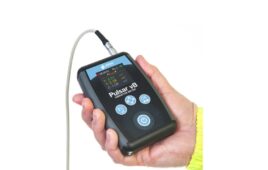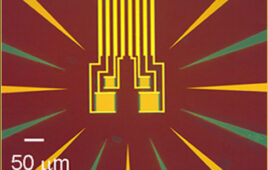 OmniVision Technologies, Inc. announced the OH02A1S—the world’s first RGB-IR medical image sensor, which provides simultaneous white-light RGB captures and infrared monochrome captures in a single CMOS sensor. While endoscopic precancer and cancer detection procedures are performed using IR light, surgeons also need RGB light to confirm any abnormalities detected using infrared. Previously, this could only be accomplished by integrating two independent imager sensors, which resulted in endoscopes with a larger size, higher cost, and higher power consumption, thereby excessively heating the tip of the endoscope. The new OH02A1S enables the designers of chip-on-tip endoscopes for cancer detection to eliminate a second image sensor, thereby overcoming the drawbacks of a two imager design. These improvements allow the development of small outer diameter (OD) endoscopes for cancer detection and diagnosis procedures such as indocyanine green (ICG), and fluorescence, chromo, and virtual endoscopy.
OmniVision Technologies, Inc. announced the OH02A1S—the world’s first RGB-IR medical image sensor, which provides simultaneous white-light RGB captures and infrared monochrome captures in a single CMOS sensor. While endoscopic precancer and cancer detection procedures are performed using IR light, surgeons also need RGB light to confirm any abnormalities detected using infrared. Previously, this could only be accomplished by integrating two independent imager sensors, which resulted in endoscopes with a larger size, higher cost, and higher power consumption, thereby excessively heating the tip of the endoscope. The new OH02A1S enables the designers of chip-on-tip endoscopes for cancer detection to eliminate a second image sensor, thereby overcoming the drawbacks of a two imager design. These improvements allow the development of small outer diameter (OD) endoscopes for cancer detection and diagnosis procedures such as indocyanine green (ICG), and fluorescence, chromo, and virtual endoscopy.
With OmniVision’s OH02A1S image sensor, both IR and RGB images can now be captured using a single chip, allowing the surgeon to switch between high quality RGB and IR in real time, or to display both images simultaneously on one (overlay) or two (side-by-side) monitors. Additionally, the smaller size and reduced heat allow the endoscope to reach much farther into the body than was previously possible with larger-OD, two-imager designs. Alternatively, designers can use the extra space to add more or larger illumination (fiber or LED), or a larger working channel for endoscopic tools.
The OH02A1S features the 1.4 micron PureCel pixel architecture with 4×4 binning for the highest image quality. This architecture offers high quantum efficiency for excellent low-light performance and a high dynamic range for clarity in scenes with widely contrasting bright and dark areas. The sensor can provide 1080p (1920×1080) resolution at 60 frames per second (fps) or 720p (1280×720) at 90 fps, via a 2-lane MIPI serial output. The OH02A1S also integrates 2 kilobits of one-time programmable memory on-chip. It consumes just 90 milliwatts at full power, generating less heat for greater patient comfort.
OmniVision’s new OH02A1S image sensor is available today in a 1/6-inch optical format and a compact 3.8×2.9mm chip-scale package. For more information, contact your OmniVision sales representative: www.ovt.com/contact-sales.
Filed Under: Sensor Tips




